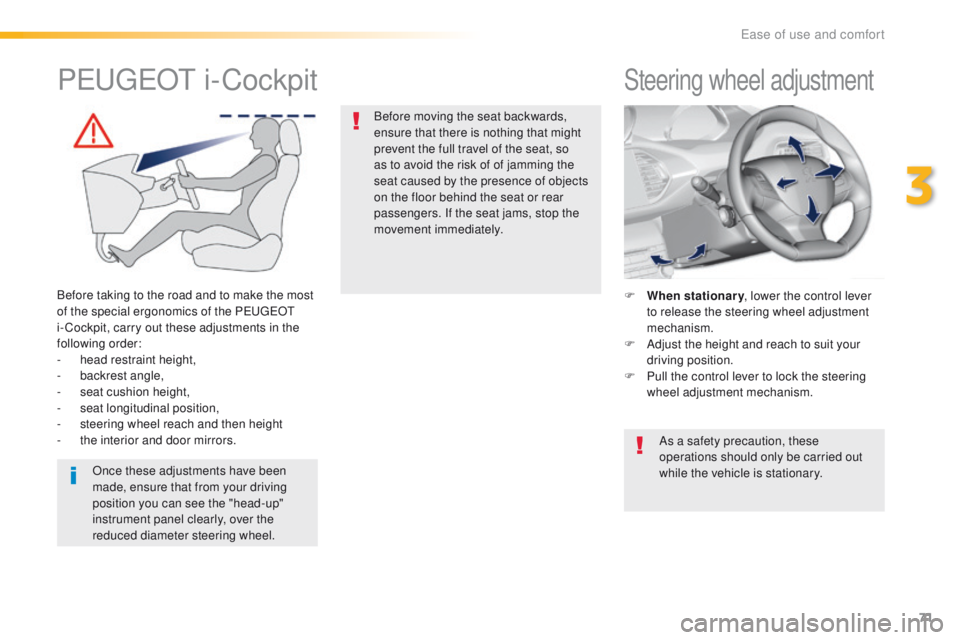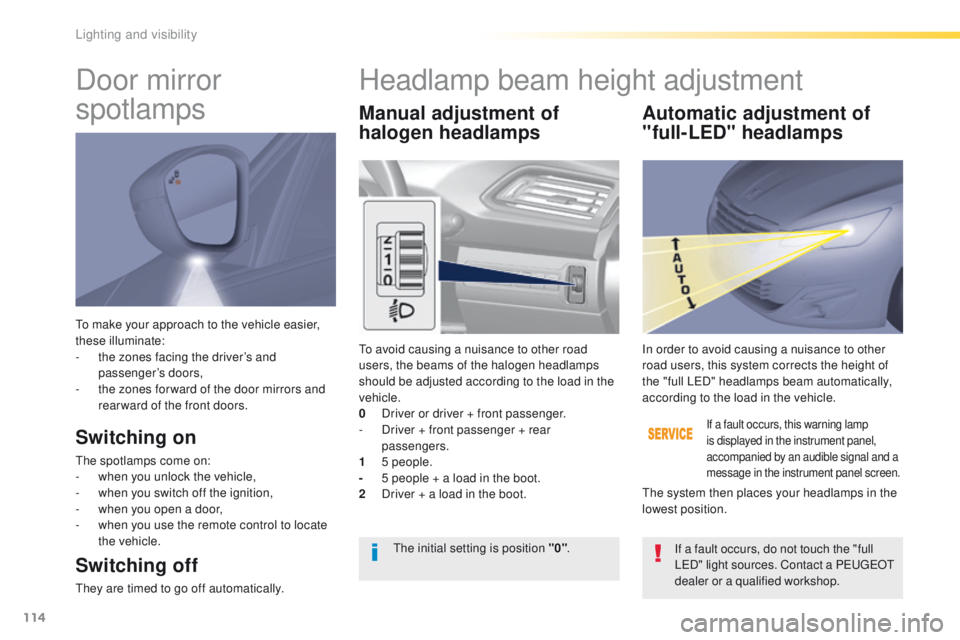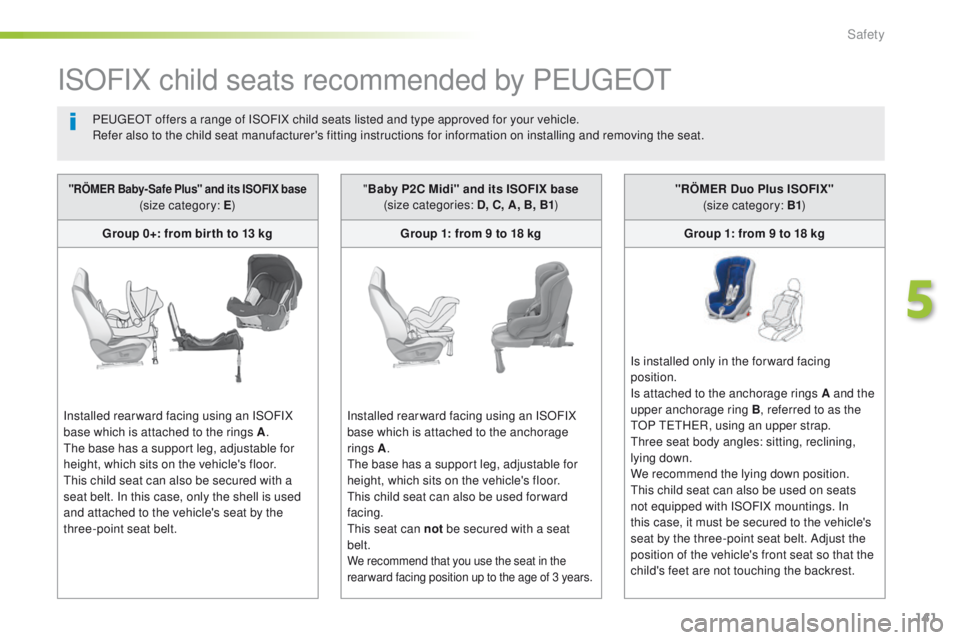Page 4 of 396

.
.
Over view
Instrument panel 12
Indicator and warning lamps
1
3
ga
uges and indicators
2
8
Distance recorders
3
2
tr
ip computer
3
4
to
uch screen
3
7
Setting the date and time
4
4Remote control key
4
8
"Keyless e
n
try and Starting" with remote
control 54
"Keyless e
n
try and Starting"
on your person
5
6
Boot
59
Alarm
65
el
ectric windows
6
9
P
e
uge
Ot
i- Cockpit
7
1
Steering wheel adjustment
7
1
Front seats
7
2
Rear seats (hatchback)
7
7
Rear seats (SW)
7
8
Interior fittings
8
0
Front armrest 8 2
Boot fittings (hatchback)
8
6
Boot fittings (SW)
87
H
eating and Ventilation
9
0
Heating
9
2
Manual air conditioning
9
2
Manual air conditioning (
to
uch screen)
9
4
Dual-zone digital air conditioning (
to
uch screen)
9
6
Front demist - defrost
1
01
Rear screen demist - defrost
1
02
Panoramic sunroof
1
03
Courtesy lamps
1
04
Interior mood lighting
1
05Mirrors
10 6
Lighting control stalk
1
08
Direction indicators
1
11
Daytime running lamps
1
12
Automatic illumination of headlamps
1
12
Side spotlamps
1
14
Headlamp beam height adjustment
1
14
Wiper control stalk
1
15
Automatic rain sensitive wipers
1
17
Hazard warning lamps 1 19
em
ergency or assistance call
1
19
H or n
12
0
e
SC system
1
20
Seat belts
1
23
Airbags
1
26
Child seats
1
30
Deactivating the passenger's front airbag
1
33
ISOFIX mountings and child seats
1
39
Child lock
1
45
eco-driving
In struments Access
ea
se of use and comfort Lighting and visibility
Safety
Contents
Page 73 of 396

71
Steering wheel adjustment
F When stationary, lower the control lever
to release the steering wheel adjustment
mechanism.
F
A
djust the height and reach to suit your
driving position.
F
P
ull the control lever to lock the steering
wheel adjustment mechanism.
As a safety precaution, these
operations should only be carried out
while the vehicle is stationary.
PeugeOt i -Cockpit
Before taking to the road and to make the most
of the special ergonomics of the Pe
ugeOt
i- Cockpit, carry out these adjustments in the
following order:
-
hea
d restraint height,
-
b
ackrest angle,
-
sea
t cushion height,
-
s
eat longitudinal position,
-
s
teering wheel reach and then height
-
t
he interior and door mirrors.Once these adjustments have been
made, ensure that from your driving
position you can see the "head-up"
instrument panel clearly, over the
reduced diameter steering wheel. Before moving the seat backwards,
ensure that there is nothing that might
prevent the full travel of the seat, so
as to avoid the risk of of jamming the
seat caused by the presence of objects
on the floor behind the seat or rear
passengers. If the seat jams, stop the
movement immediately.
3
ease of use and comfort
Page 74 of 396
72
Front seats with manual adjustments
F Raise the control and slide the seat forwards or backwards. F
P ull the control upwards to raise or push
it downwards to lower, as many times as
required, to obtain the position required. F
tu rn the knob to adjust the backrest.
Forwards-backwards
HeightSeat backrest angle
As a safety measure, seat adjustments should only be carried out when stationary.
F t
u
rn the knob manually to obtain the
desired level of lumbar support.
LumbarBefore moving the seat backwards, ensure that there is nothing that might prevent the full
travel of the seat, so as to avoid the risk of of jamming the seat caused by the presence of
objects on the floor behind the seat or rear passengers. If the seat jams, stop the movement
immediately.
ease of use and comfort
Page 77 of 396
75
Heated seats control
0: Of f.
1 : Low.
2 : Medium.
3 : High.
F
u
s
e the adjustment wheel to switch on and
select the level of heating required:
With the engine running, the front seats can be
heated separately.
F
to r
aise the head restraint, pull it upwards.
F
t
o r
emove the head restraint, press the
lug
A and pull the head restraint upwards.
F
to put the head restraint back in place, engage
the head restraint stems in the openings
keeping them in line with the seat back.
F to lower the head restraint, press the lug A and the head restraint at the same time.
th
e head restraint is fitted with a frame
with notches which prevents it from
lowering; this is a safety device in case
of impact.
The adjustment is correct when the
upper edge of the head restraint is
level with the top of the head.
Never drive with the head restraints
removed; they must be in place and
adjusted correctly.
Head restraint height
Additional adjustments
3
Ease of use and comfort
Page 84 of 396
82
Front armrest
the height and longitudinal position of the armrest cover can be adjusted for greater comfort.
F
R
aise the cover to the required position
(low, intermediate or high).
F
I
f you raise the cover slightly beyond the
high position, guide it when lowering it to
the low position. F
Ra
ise the lever.
F
Ra
ise the cover fully.
F
S
lide the cover fully for wards or rear wards.
Storage
Longitudinal adjustment
Height adjustment
ease of use and comfort
Page 116 of 396

114
to make your approach to the vehicle easier,
these illuminate:
-
t
he zones facing the driver’s and
passenger’s doors,
-
t
he zones for ward of the door mirrors and
rear ward of the front doors.
Door mirror
spotlamps
Switching on
the spotlamps come on:
- w hen you unlock the vehicle,
-
w
hen you switch off the ignition,
-
w
hen you open a door,
-
w
hen you use the remote control to locate
the vehicle.
Switching off
they are timed to go off automatically.
Manual adjustment of
halogen headlamps Automatic adjustment of
"full-LED" headlamps
to avoid causing a nuisance to other road
users, the beams of the halogen headlamps
should be adjusted according to the load in the
vehicle.
0
D
river or driver + front passenger.
-
D
river + front passenger + rear
passengers.
1
5
people.
-
5 p
eople + a load in the boot.
2
D
river + a load in the boot.
If a fault occurs, this warning lamp
is displayed in the instrument panel,
accompanied by an audible signal and a
message in the instrument panel screen.
In order to avoid causing a nuisance to other
road users, this system corrects the height of
the "full L e
D
" headlamps beam automatically,
according to the load in the vehicle.
th
e system then places your headlamps in the
lowest position.
th
e initial setting is position "0" .
If a fault occurs, do not touch the "full
L
eD
" light sources. Contact a P
e
uge
Ot
d
ealer or a qualified workshop.
Headlamp beam height adjustment
Lighting and visibility
Page 139 of 396
137
Locations for child seats secured with the seat
belt
Weight of the child / indicative age
Seat Less than 13 kg
(groups 0 (b) and 0+)
up t
o 1 year approx From 9 to 18 kg
(g r o u p 1)
From 1 to 3 years approx
From 15 to 25 kg (group 2)
From 3 to 6 years approx
From 22 to 36 kg (group 3)
From 6 to 10 years approx
Front passenger seat (c) (d)
-
w
ith height adjustment U (R)U (R)U (R)U (R)
-
w
ithout height adjustment
(straightening the backrest) U (R)
U (R)U (R)U (R)
In accordance with the
e
u
ropean regulation, this table indicates the options for the installation of child seats secured using the seat belt and universally
approved (a) in relation to the weight of the child and the seat in the vehicle.
Hatchback
Outer rear seats (e) UUUU
Centre rear seat (e) U (f )U (f ) XX
SW
Outer rear seats (e) UUUU
Centre rear seat (e) XXXX
5
Safety
Page 143 of 396

141
ISOFIX child seats recommended by PeugeOt
PeugeOt offers a range of ISOFIX child seats listed and type approved for your vehicle.
Refer also to the child seat manufacturer's fitting instructions for information on installing and removing the seat.
"RÖMER Baby- Safe Plus" and its ISOFIX base (size category: E)
Group 0+: from bir th to 13 kg
Installed rearward facing using an ISOFIX
base which is attached to the rings A .
th
e base has a support leg, adjustable for
height, which sits on the vehicle's floor.
th
is child seat can also be secured with a
seat belt. In this case, only the shell is used
and attached to the vehicle's seat by the
three-point seat belt. "
Baby P2C Midi" and its ISOFIX base
(size categories: D, C, A, B, B1 )
Group 1: from 9 to 18 kg
Installed rearward facing using an ISOFIX
base which is attached to the anchorage
rings A .
th
e base has a support leg, adjustable for
height, which sits on the vehicle's floor.
th
is child seat can also be used for ward
facing.
th
is seat can not be secured with a seat
belt.
We recommend that you use the seat in the
rear ward facing position up to the age of 3 years.
"RÖMER Duo Plus ISOFIX" (size category: B1 )
Group 1: from 9 to 18 kg
Is installed only in the for ward facing
position.
Is attached to the anchorage rings A and the
upper anchorage ring B , referred to as the
tO
P
tet
HeR
, using an upper strap.
th
ree seat body angles: sitting, reclining,
lying down.
We recommend the lying down position.
th
is child seat can also be used on seats
not equipped with ISOFIX mountings. In
this case, it must be secured to the vehicle's
seat by the three-point seat belt. Adjust the
position of the vehicle's front seat so that the
child's feet are not touching the backrest.
5
Safety